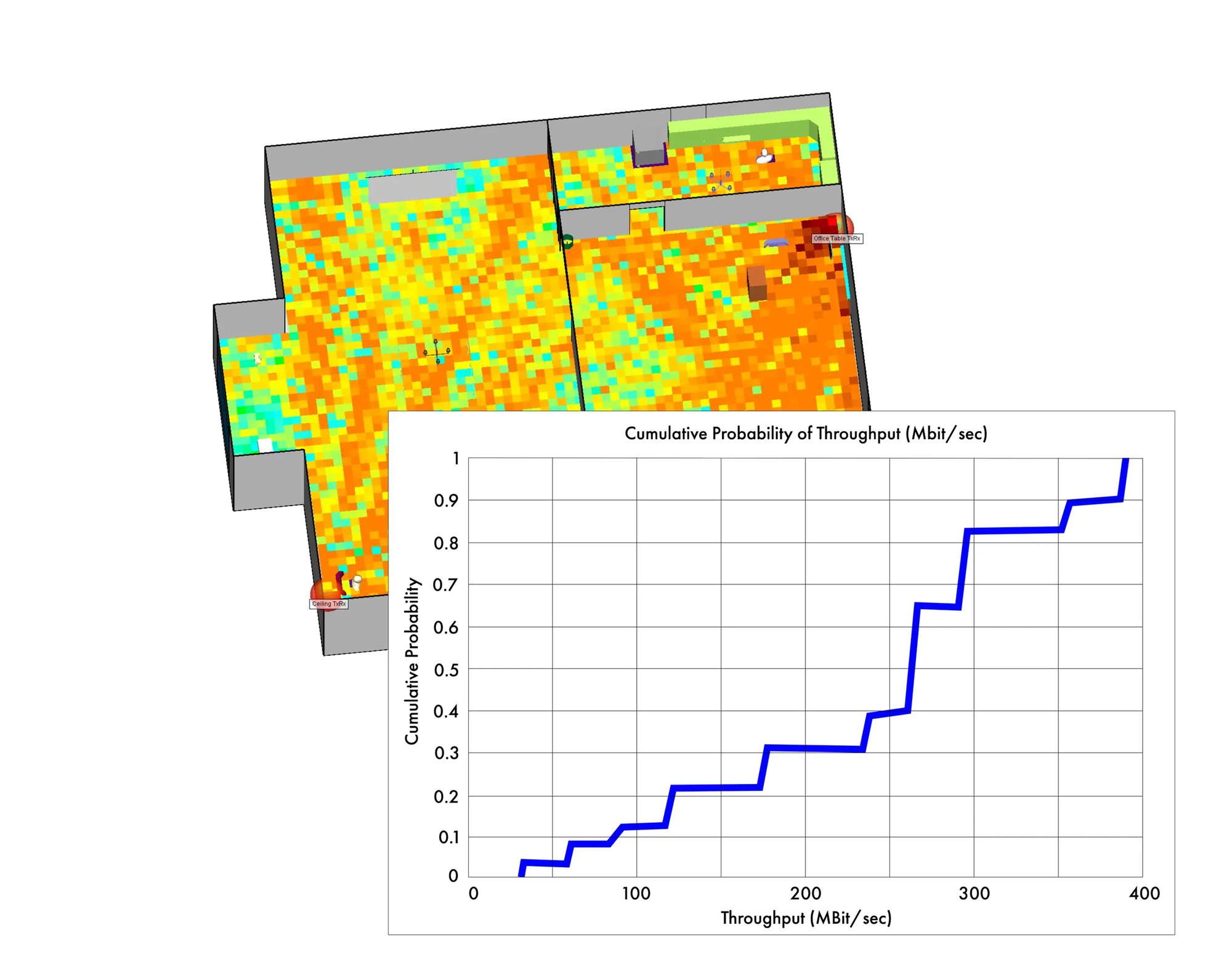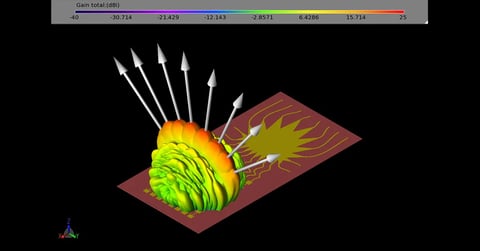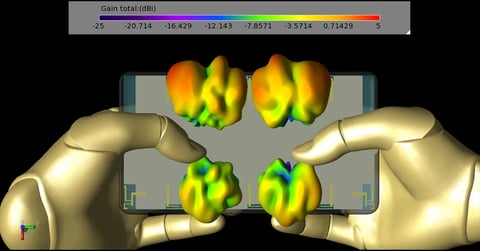- Applications
- MIMO and 5G Simulation Software
- MIMO and Array Design for 5G

MIMO and Array Design for 5G
XFdtd and Wireless InSite work together with complementary features for effective 5G MIMO and array design.

Antenna engineers favor advanced antenna systems capable of beam steering and multiple data stream transmission in order to meet 5G throughput requirements. Designing such a device is a difficult task because many factors are involved in a device’s performance:
-
Antenna coupling within a device’s case
-
Effects of multipath propagation
-
Data transfer schemes
XFdtd and Wireless InSite ensure a comprehensive device design process, from simulating the initial antenna pattern to computing throughput performance in a multipath channel model. Together the products ensure a device will work well in its intended environment.

Four possible beams for a 28 GHz array.
Stand-Alone Device Performance with XFdtd
Remcom’s time-domain electromagnetic simulation software, XFdtd, enables in-depth analysis of a device’s stand-alone performance. Detailed CAD models of the antennas, PCB, and device assembly are imported from Pro Engineer, Allegro, and other software packages. The following results are available from a single finite-difference time-domain (FDTD) simulation:
-
Antenna isolation
-
Envelope correlation
-
Antenna efficiency
-
Antenna patterns
An RF engineer needs to go beyond stand-alone antenna performance in order to ensure sufficient 5G device performance. Results from an XFdtd simulation that characterize the performance of an antenna are easily exported to Wireless InSite where the device is analyzed in its intended environment.

Laptop with a four element MIMO antenna.

Antenna element patterns and relative positions can be exported from XFdtd and loaded into Wireless InSite for channel simulations.
Exporting Antenna Data for Channel Simulations
Channel simulations provide a means to predict how systems will perform within a realistic setting, such as a connected home, indoor office environment, or an outdoor urban or suburban scene. Realism for this type of analysis is considerably improved by including the key characteristics of a device’s antennas as predicted by XFdtd. To facilitate this, XFdtd can export the following types of antenna data:
-
3D antenna radiation patterns, including:
-
Unique pattern for each element of MIMO antenna
-
Frequency-specific patterns
-
-
MIMO antenna element layouts
-
MIMO codebooks
-
MIMO multi-port S-parameters
For MIMO systems, the 3D layouts can be exported so that the full physical definition of an antenna or array can be directly imported. In addition, optimization scripts can create custom codebooks, and multi-port S-parameters can be used to incorporate the impact of mutual coupling on performance analysis.
Simulating the 3D Multipath Channel
3D propagation scenarios can be modeled in Remcom’s wireless prediction software, Wireless InSite. Site-specific and generic test environments are created by importing terrain, defining building floor plans, specifying base station or access point locations, and providing material information. MIMO antenna designs from XFdtd are then tested in applications including:
-
City blocks for small cell base station deployment
-
Outdoor-to-indoor for fixed wireless access scenarios
-
Office buildings for WiFi access planning

Office layout with access point (AP) and single laptop location.
%202.webp?width=2000&height=938&name=Copia%20de%20image-asset%20(2)%202.webp)
Location of AP in corner of office.
Wireless InSite uses high-fidelity ray-tracing models to determine multipath propagation through the 3D environment. These industry leading capabilities include the ability to analyze:
-
3D terrain, buildings, and floor plans
-
Fine structural details including curbs, window frames, chairs, and desks
-
Diffuse scattering at millimeter waves
-
Attenuation from trees, shrubs, and other foliage
Transmitters and receivers are comprised of one or more antenna elements. Wireless InSite computes the link between each antenna element on the transmitter and receiver and reports results including:
-
Complex impulse response at each receiver
-
Received power
-
Coverage maps
-
Power delay profiles
-
H-matrices connecting each antenna element on a base station or access point to those on a UE or device
.webp?width=2000&height=929&name=Copia%20de%20image-asset%20(3).webp)
Propagation paths between AP and single laptop location.

Throughput coverage for all laptop locations.
MIMO and Communication System Analysis
Given the MIMO antenna design and 3D channel characteristics, Wireless InSite’s Communication Systems Analyzer allows the RF engineer to evaluate a 5G device’s operation in the intended scenario.
To start, a MIMO technique is applied to each transmitter and receiver. This will improve a system’s performance by increasing the signal-to-interference-plus-noise ratio (SINR), providing multiple parallel data streams, or both. Wireless InSite models the following MIMO techniques:
-
Antenna diversity
-
Spatial multiplexing
-
Beamforming
MIMO techniques determine how data is transmitted through the 3D environment. Once that is known, Wireless InSite determines how much data can be transmitted. The following metrics are accessed for each data stream and point-to-point link:
- Throughput and capacity
- Bit error rate (BER)
- Noise, interference, and SINR
This results in a powerful tool that engineers use to determine if their device will meet 5G performance requirements in a realistic operating environment.
When multi-port S-parameters are imported from measurement data or full-wave simulations, the analysis can capture the impact of mutual coupling between MIMO elements. MIMO systems rely on channels that are uncorrelated, so mutual coupling can degrade the performance of MIMO techniques like spatial multiplexing, which aims to generate orthogonal data streams. It can also degrade MIMO beamforming if codebook weights are not tuned to compensate for it, as shown in the figure to the right. During the MIMO analysis, the S-parameters are applied to capture the effect of mutual coupling in the channel matrix, and later analysis will then incorporate this effect in the predicted performance in terms of SINR and throughput.
.webp?width=400&height=377&name=MIMO_BF_wMutualCoupling%20(1).webp)
Example showing how mutual coupling can degrade MIMO beamforming, if sufficiently strong and not compensated for in codebook weighting coefficients.
Additional Information
-

Webinars
5G Antenna Array Design Features in XFdtd EM Simulation Software
This webinar demonstrates XFdtd’s 5G antenna array design features, including workflow enhancements for modeling complex devices at millimeter wave frequencies. This webinar demonstrates performance metrics for 5G beam steering applications via the new CDF of EIRP plot as well as XF’s enhanced matching network design integration with Optenni Lab™ matching circuit optimization software.
Explore Resource -

Application Examples
Design and Simulation of 28 GHz Beamforming System and Antenna Array for 5G Network Base Stations
This example is a more complete device for 28 GHz beamforming for 5G networks and includes an 8x8 patch antenna array, 1 to 8 power dividers and a Rotman lens initial stage.
Explore Resource
Application Examples
EM Simulation of 28 GHz Series-Fed Patch Antenna Array for 5G
Series-fed patch elements forming an array are simulated to demonstrate antenna performance and beamforming including S-parameters, gain, and effective isotropic radiated power (EIRP) at 28 GHz. Beam steering is performed in one plane by adjusting the phasing at the input ports to each of eight elements.
Explore Resource
Application Examples
Simulation of MIMO Handset Antenna Array Performance with Varying Hand Positions
Performance of a 12-port handset antenna array operating in LTE bands 42/43 (3400-3800 MHz) and band 46 (5150-5925 MHz) is analyzed in XFdtd for varying hand hold positions on the device. The results computed include S-parameters, Gain, Efficiency and Envelope Correlation Coefficient.
Explore Resource -

Videos
How To Simulate Throughput For A New Device Design
In this short video from IMS 2018, Remcom's product marketing manager, Jeff Barney, describes the process of simulating the antenna element, modeling the channel propagation, and calculating the throughput modulation.
Explore Resource -

Publications
What’s New in XFdtd®
XFdtd Release 7.11.1 introduces several enhancements designed to elevate simulation accuracy, expand analysis capabilities, and streamline the engineering workflow. This release reflects Remcom’s continued focus on solving high-value challenges in antenna design, PCB modeling, and phased array system development.
Explore Resource
Publications
Transient EM/Circuit Co-Simulation in XFdtd: A Closer Look at TVS Diodes for ESD Protection
This paper introduces XFdtd’s transient EM/circuit co-simulation capability, which combines the strength of 3D full-wave electromagnetic simulation with the flexibility of circuit solvers.
Explore Resource
Publications
Using EM Simulation for 5G Design E-Book
Download examples that demonstrate how EM simulation software solves challenges related to 5G and MIMO. Examples include MIMO and array design, 5G urban small cells, mmWave and beamforming.
Explore Resource
Save time and reduce costs.
Contact Remcom today for a customized solution to your most complex electromagnetic challenges.
Request a Quote